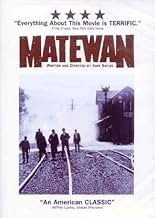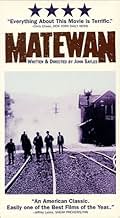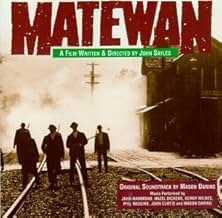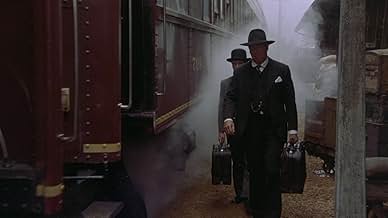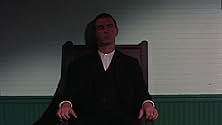ÉVALUATION IMDb
7,9/10
10 k
MA NOTE
Un syndicaliste arrive dans une communauté minière assiégée brutalement et violemment dominée.Un syndicaliste arrive dans une communauté minière assiégée brutalement et violemment dominée.Un syndicaliste arrive dans une communauté minière assiégée brutalement et violemment dominée.
- Nommé pour 1 oscar
- 3 victoires et 8 nominations au total
Michael B. Preston
- Ellix
- (as Michael Preston)
Avis en vedette
After a streak of Godard films that left me a little exhausted, I was looking for a big narrative to immerse myself in, a film where artifice does not jump to our attention but is transparent and the world of the film believable. I immediately remembered about John Sayles and his nouvellas of cinema. With Lone Star I bemoaned the lack of a visual imagination, but coming to a Sayles film for a narrative like I did with Matewan, I leave completely satisfied. The man excels in telling us stories with scope and values of importance.
What a lovely world he creates here, among the derelict shacks and cabins of the Pennsylvania foothills of Matewan a moral struggle is fought, flawed characters with faces blackened by coaldust fumble with great ideals and big hopes for a better future, and the one thing that stands between them and justice is their own prejudice. I like how the film suggests that for the collective to be reformed the individual must be reformed first, that we need to look inwards first before we make a stand. The stand in the film is heroic but also desperate, a bit of a lawless old West on the way to emancipation. John Sayles is a leftist and this comes across loud and clear in Matewan, but unlike a Godard film like Week End, Sayles doesn't call for blood, he calls for social justice.
The narrative here sprawls in and out of log cabins where sullen faces plot strikes and discuss ideals, in and out of makeshift tents and muddy town streets where coalminers live and die and sing, now a fiddle or harmonica is calling out from the dark the sad tune of a life of suffering, and the finale is sealed with a shootout filled with tragedy and hope. Sayles' camera doesn't intrude in any of this, rather it's invited in and hankers down out of way to quietly listen or conspire.
Matewan makes a great doublebill with Martin Ritt's The Molly Maguires, another forlorn drama of the oppressed that speaks of moral devastation in the Pennsylvania coal fields, but more, it stands by itself as one of the great American narratives of the 80's.
What a lovely world he creates here, among the derelict shacks and cabins of the Pennsylvania foothills of Matewan a moral struggle is fought, flawed characters with faces blackened by coaldust fumble with great ideals and big hopes for a better future, and the one thing that stands between them and justice is their own prejudice. I like how the film suggests that for the collective to be reformed the individual must be reformed first, that we need to look inwards first before we make a stand. The stand in the film is heroic but also desperate, a bit of a lawless old West on the way to emancipation. John Sayles is a leftist and this comes across loud and clear in Matewan, but unlike a Godard film like Week End, Sayles doesn't call for blood, he calls for social justice.
The narrative here sprawls in and out of log cabins where sullen faces plot strikes and discuss ideals, in and out of makeshift tents and muddy town streets where coalminers live and die and sing, now a fiddle or harmonica is calling out from the dark the sad tune of a life of suffering, and the finale is sealed with a shootout filled with tragedy and hope. Sayles' camera doesn't intrude in any of this, rather it's invited in and hankers down out of way to quietly listen or conspire.
Matewan makes a great doublebill with Martin Ritt's The Molly Maguires, another forlorn drama of the oppressed that speaks of moral devastation in the Pennsylvania coal fields, but more, it stands by itself as one of the great American narratives of the 80's.
If you are from Matewan, you know the shock of having this movie be about your hometown. I can't help but wonder if James Earl Jones was thinking "Why the hell are we making a movie about this place??" I think the population when I lived there (most of my life) was somewhere around 1200. Probably hasn't grown much. I still keep in contact with a few people from there. My dad owned a bar there called the Silver Dollar, and he worked in the mines at one time, as did my mother and grandfather. I've heard stories of how the real Matewan Massacre went, along with Bloody Mingo and all the rest, and from what I've heard from my family, this movie is pretty close to the truth. Matewan has always been a rough town, and even today fights are commonplace in this little one street town. It's pretty desolate, with no real business, no industry, and the coal mines are almost mined out. The nearest decent place is Williamson (WV) or Pikeville, Kentucky, a small college town. I miss home sometimes, but at least I can watch the movie and be reminded of home. One thing about it... it's an entertaining movie. Hope you enjoy it as much as I did, but then again, I'm biased.
10rrenon
John Sayles is a national treasure! Ferociously independent --most of his films are made with privately organized funds-- and working with what has become a repertory company --most of his actors return to work with him for less than they would get elsewhere-- he has never made an uninteresting film. Even when his films may vary in overall quality, from merely good to great, they are each interesting and arresting.
My mother was an organizer in the southwest coal counties of West Virginia, arriving there in 1926 (having left college), near the end of the coal wars. Her only comment on the film, when I screened it for her before she died in 1988,was that the working conditions and the living conditions of the miners and their families were far worse than depicted in the film. She always spoke at union meetings surrounded by a body guard of 10-20 armed miners. A number of her young colleagues were assassinated (there's no other appropriate word for how they died).
The murder of Sid Hatfield, the town sheriff of Matewan, in the year following the year portrayed in the film, in broad daylight on the McDowell County courthouse steps precipitated the largest insurrection in the U.S. since the Civil War. More than 10,000 armed miners from the six coal counties, descended on the court house looking for the private detectives and law "enforcement" officers who were the assassins. They took over the court house and the town, and threatened open insurrection. Thew film is a great film. Unfortunately, like most of John Sayles's films, it did not play to a large audience.
My mother was an organizer in the southwest coal counties of West Virginia, arriving there in 1926 (having left college), near the end of the coal wars. Her only comment on the film, when I screened it for her before she died in 1988,was that the working conditions and the living conditions of the miners and their families were far worse than depicted in the film. She always spoke at union meetings surrounded by a body guard of 10-20 armed miners. A number of her young colleagues were assassinated (there's no other appropriate word for how they died).
The murder of Sid Hatfield, the town sheriff of Matewan, in the year following the year portrayed in the film, in broad daylight on the McDowell County courthouse steps precipitated the largest insurrection in the U.S. since the Civil War. More than 10,000 armed miners from the six coal counties, descended on the court house looking for the private detectives and law "enforcement" officers who were the assassins. They took over the court house and the town, and threatened open insurrection. Thew film is a great film. Unfortunately, like most of John Sayles's films, it did not play to a large audience.
This is a powerful film depicting both the conditions under which most mineworkers labored and the social conditions existing in the 1920-1930 era of our American history. It accurately portrays the manner in which powerful industrial interests manipulated the worker's economic dependency using 'script' issued in lieu of lawful and legal tender and controlled the acquisition of basic needs such as shelter, food, and clothing. By "owning" the stores, controlling employment, threatening the physical well-being of its employees, and hiring of thugs to intimidate individuals and their ability to implement any organized mutual assistance, these wealthy and powerful companies sought to (and succeeded in ) maximizing their profits by using the labor of the poor and impotent at almost no cost to the company.
One needs to search intensely to finally reveal the true history of our period of industrialization. It is of great credit to the producer's and director's of such films as "Matewan" that we can see clearly the history and ongoing great struggle between the working class and the wealthy elite to obtain their proper share of "profits."
This is a film where one enters a theater to be "entertained", but leaves having the stirrings of compassion and outrage raised in their hearts. It reminds us that there is a human price paid for economic gain.
One needs to search intensely to finally reveal the true history of our period of industrialization. It is of great credit to the producer's and director's of such films as "Matewan" that we can see clearly the history and ongoing great struggle between the working class and the wealthy elite to obtain their proper share of "profits."
This is a film where one enters a theater to be "entertained", but leaves having the stirrings of compassion and outrage raised in their hearts. It reminds us that there is a human price paid for economic gain.
10vic-45
Looking back to 1987 I have to wonder why this masterpiece was not nominated for Best Picture. But then again, this is the same institution that voted for films such as Braveheart and Forrest Gump. Is the Academy afraid of John Sayles?
See Matewan for its wonderful portrayal of the events that occurred in West Virginia in the 1920's. See this film for its phenomenal cast. See it for its beautiful cinematography. There is an ethereal glow that envelopes the characters and buildings of Matewan.
There is also an underlying allegorical depiction of Christ and his followers. Chris Cooper is a saint. He reminds me of Gary Cooper a little bit. He has such an unusual handsome face. He is the protagonist joined by James Earl Jones, Mary Mcdonnell, and Will Oldman. Perhaps the most fascinating character is that of the Sheriff portrayed by Strathairn. He is the angel on the black horse who carries with him the wrath of God. Just watch him stand up against the bad guys.
The main antagonistic characters are pure evil. They terrorize the inhabitants of Matewan with juvenile antics.
Please see this film and be prepared to have it imbedded in your mind for the rest of your life. This is what great film making is about
See Matewan for its wonderful portrayal of the events that occurred in West Virginia in the 1920's. See this film for its phenomenal cast. See it for its beautiful cinematography. There is an ethereal glow that envelopes the characters and buildings of Matewan.
There is also an underlying allegorical depiction of Christ and his followers. Chris Cooper is a saint. He reminds me of Gary Cooper a little bit. He has such an unusual handsome face. He is the protagonist joined by James Earl Jones, Mary Mcdonnell, and Will Oldman. Perhaps the most fascinating character is that of the Sheriff portrayed by Strathairn. He is the angel on the black horse who carries with him the wrath of God. Just watch him stand up against the bad guys.
The main antagonistic characters are pure evil. They terrorize the inhabitants of Matewan with juvenile antics.
Please see this film and be prepared to have it imbedded in your mind for the rest of your life. This is what great film making is about
Le saviez-vous
- AnecdotesThe miners' union was broken by 1921, after President Warren G. Harding put the entire state of West Virginia under martial law and sent the army to the coalfields to defend the companies against their employees. By then, hundreds of miners had been killed, thousands arrested and jailed. It was not until 1935, under Franklin D. Roosevelt's New Deal, that union organizing was legally protected in the United States.
- GaffesLook for the sheriff to remove a gun from someone's hand (by holding the gun by the barrel) after it's been fired four or five times.
- Citations
Joe Kenehan: You think this man is the enemy? Huh? This is a worker! Any union keeps this man out ain't a union, it's a goddam club! They got you fightin' white against colored, native against foreign, hollow against hollow, when you know there ain't but two sides in this world - them that work and them that don't. You work, they don't. That's all you get to know about the enemy.
Meilleurs choix
Connectez-vous pour évaluer et surveiller les recommandations personnalisées
- How long is Matewan?Propulsé par Alexa
Détails
Box-office
- Budget
- 4 000 000 $ US (estimation)
- Brut – États-Unis et Canada
- 1 680 358 $ US
- Fin de semaine d'ouverture – États-Unis et Canada
- 23 850 $ US
- 30 août 1987
- Brut – à l'échelle mondiale
- 1 680 358 $ US
Contribuer à cette page
Suggérer une modification ou ajouter du contenu manquant


